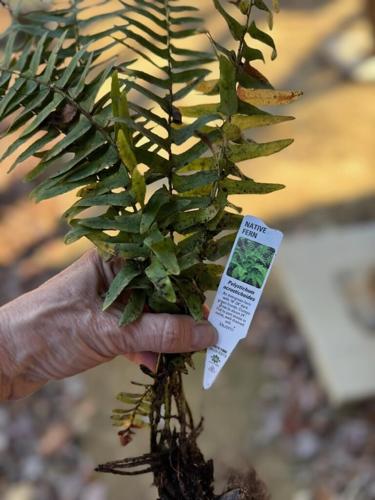Whatòòò½ÊÓƵ™s better than planting 100 ferns? Planting 200 ferns, of course!
So begins the journey of reclaiming the surrounding forest damaged by constructing a new home.
The timing is right. Major construction is done. Small inside projects and finishing details are happening. Itòòò½ÊÓƵ™s very exciting to have a cozy mountain retreat ready for the holidays òòò½ÊÓƵ” and this might be enough for some folks, but not for those who love and respect the land that drew them to the property many months ago.
What was once a magical view of forest flora and sunsets is now bare soil and tire tracks. But not for long.
The cool days of fall provide the perfect conditions for planting shrubs and certain perennials. The hot temperatures of summer can be taxing òòò½ÊÓƵ” even deadly òòò½ÊÓƵ” for new, tender plants. New plantings need water, and keeping the soil moist when the days are hot and sunny is a constant battle. Soil will retain the water and feed the plants much easier in the fall when not battling long hours of direct sun.
Determined to restore the land to better than before, the owners got busy. They began with native plants and native plants nurseries. One hundred Christmas ferns (Polystichum acrostichoides) purchased from Sunshine Farms & Gardens located in Renick, West Virginia, were placed on the hillside. It was good, but another 100 ferns would be even better, so thatòòò½ÊÓƵ™s what they did.
These perennial ferns will grow in clumps and have fronds (fern leaves) up to 24 inches high. Their dark-green color will last through the winter, and the plants will come back even stronger in the spring. Because Christmas ferns are clumping ferns, they will not spread through runners like other ferns. Dividing the clumps is the best way to propagate òòò½ÊÓƵ” even more reason to plant 200.
To add more structure and height to the reclaimed area, the owners also added 10 Serviceberry trees to the mix of ferns. Serviceberry trees will grow 15-20 feet, maybe taller, and produce a canopy of small white flowers, then berries, and for a big finale, the leaves turn a brilliant red in the fall before dropping to create a forest carpet.
Each hole was given a generous scoop of mushroom compost to promote success in all the planting. This compost is rich and filled with goodness. Whether you buy it by the truckload to plant a forest floor or by the bag for your home garden, it is a must-have and something I add to all my new garden plants. Adding this extra nutrition to the tender roots as they adjust to their new home is a crucial step.
After a visit to Rich Farms Nursery in Smithfield, Pennsylvania, just across the West Virginia border and near Morgantown, the owners are adding firs, junipers, and dogwoods to the forest. This mix of color, texture, and bloom cycle will add to what Mother Nature creates over time.
This mountain getaway is located in USDA Zone 5a. That means cooler temps earlier in the fall and later in the spring. Using plants native to the area is important. They are cultivated to survive and thrive in the area and have a built-in immunity system to withstand the ups and downs of temperatures and other climate factors.
Reclaiming Fernbank (Fernbank, named to honor the land) and adding other interest to the landscape is important. The owners want to create a haven, a place for them to enjoy now.
I have had a preview of other creative ways plants are being added to the construction site and am looking forward to learning more and watching the progress. But this is not a five-year or a ten-year project; this is a labor of love that will create a layered forest environment for animals and people to live with for many generations.










